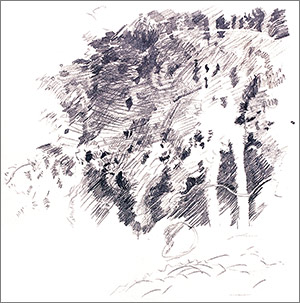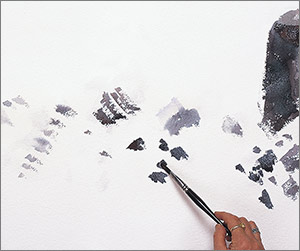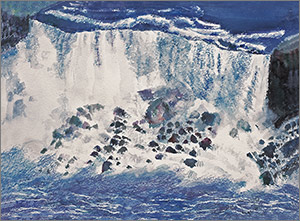Watercolour Tutorials |
||||||||||||||

How to Start Watercolour Painting
You have been making studies of apples. The next step in how to start watercolour painting is to go ahead and make a painting.
The difference between a study and a painting is that you have to take a longer look at what you are doing and think about the whole picture.
In other words, you have to arrange and compose.
You put the apple on some surface, a table, a book or even a plate, and think about the background - something simple like a piece of plain cloth or a towel over a book.

The paper in front of you is bounded by its edges - it is square or rectangular.
The objects in front of you are not bound by anything, so it is quite a good idea to have some kind of a frame, a small mount perhaps to look through and decide on the limits of your composition.
It's rather like looking through a viewfinder of a camera.
 Before you start the painting it is good to make some preparations. Do a few drawings and practice some of the difficult bits.
Before you start the painting it is good to make some preparations. Do a few drawings and practice some of the difficult bits.
Also, make some tonal studies. These are studies done in the different tones of just one colour.
All these things make you use your eyes and notice more in the scene you are going to paint.
The moment comes when you are about to start the actual painting and it can be daunting. An army of doubts can race forward to meet your advancing forces and critical, sneering voices wither your confidence and pour scorn on your bravery.
There are things you can do to avoid these nerves.
Take care of yourself, be rested and relaxed.
Deal with any pressing administrative concerns like paying bills.
Make those phone calls to the plumber - get all the practical matters out of the way. This will get you some way along the road to inner peace if not quite the final destination.
If you can meditate or pray this is even better. I like to thank the creator for the opportunity to express the beauty of the creation.
But if you feel that this is too theistic, do something like playing some of your favourite music and then keep silent for a few minutes.
This really does help you to let go of the world.
 Then you want to take your brush and dip it in some light colour (or if you feel too nervous, use no colour at all!) and make a gesture on the paper with it, which for you should sum up the whole feeling of the painting.
Then you want to take your brush and dip it in some light colour (or if you feel too nervous, use no colour at all!) and make a gesture on the paper with it, which for you should sum up the whole feeling of the painting.
This is what the Chinese call the Chi of the painting and they do this superbly.
If you don't make a very strong dark mark, it doesn't really matter what this looks like. It just helps to give some structure to the composition and helps you to place the shapes.
Now you want to put in the areas of the darkest colour. I like to do this at once for two reasons.
Firstly, it keeps the picture together.
Secondly, it is good to make the darkest darks early on, because if your paper gets wet, you can't add any more dark to it.
The advantage of drawing carefully as a preparation is that you can see where the dark areas are. They define the shapes for you.
Then while the paint is still wet, you can put in the mid-tones and the lighter tones. Or you can wait until the washes dry.
Usually there are some areas where you can't let colours run in - maybe you are painting a red apple against a blue background. You can let the colours in the apple blend together but you will have to wait until it dries before you put in the background.
In how to start watercolour painting, I can't really advise you more at this stage without having an actual painting in front of me.
As a general rule, you want to work your way round the painting without getting too obsessed with any part until you have covered the whole area.
There will come a time when you will have to let go. It is very tempting to become obsessed with details. They are not so important. The details you want to put in are the ones which are essential to the story.
Details can be a terrible distraction - they can tie you into one part of the painting so that you no longer see the whole and once you become worried about them, this is what your painting will express.
If you feel that a painting has lost its first fine exuberance, there are all sorts of things you can do to detach yourself - you don't need to give up.
- You can give yourself a rest - make a cup of tea, go out for a walk.
- You can look at it from a different angle - I find a mirror is very helpful.
- You can even put the paper away for quite a long period and then come back to it.
It is quite amazing how, when you do these things, the answer comes.
So don't ever "worry" at a painting - it is a sign of tiredness when you do this.
Finally you reach the point when either you have to admit defeat or celebrate victory.
Never admit defeat
If the painting turns out to be not as good as its original promise, treat it with respect as a step on the way to the goal.
There is very little tuition available in how to watercolor paint.
Most people have to learn by trial and error.
Never tear up what you have done. Keep it for a while and look at it with fresh eyes. It might be that there is something you can do to rescue the painting, but if there isn't, just respect it for what it has taught you.
It is what I call a "learner". You can tear it up at this point; I turn them over and use the backs for experimental work. You can always do another and this will turn out better.
 But let us imagine that you have managed to escape the pitfalls of despair, avoided the obsessive detail trap and have resolved any other problems by taking a brief trip to Hawaii, before returning to complete your "Still life with apples".
But let us imagine that you have managed to escape the pitfalls of despair, avoided the obsessive detail trap and have resolved any other problems by taking a brief trip to Hawaii, before returning to complete your "Still life with apples".
Well done!
Now you can do some flowers.
Copyright © 2019 Christian Wharton. All rights reserved.